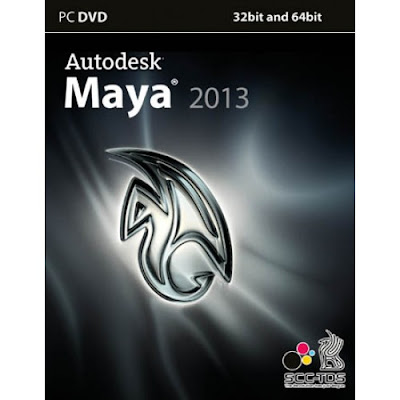Reach new levels of creativity with a powerful set of 3D animation tools.
Autodesk Entertainment Creation Suite
Experience Creative Freedom with Industry-Leading 3D Tools
Included Softwares
Autodesk Maya

Autodesk® Maya® 3D animation software delivers a comprehensive creative feature set with tools for animation, modeling, simulation, rendering, matchmoving, and compositing on a highly extensible production platform. For visual effects, game development, post production, or other 3D animation projects, Maya offers toolsets to help meet demanding production requirements. Maya 2013 adds tools that help facilitate parallel workflows and complexity handling; powerful new creative toolsets; and productivity enhancements to help you create higher quality content quickly.
Autodesk 3ds Max
Autodesk® 3ds Max® and Autodesk® 3ds Max® Design software provide powerful, integrated 3D modeling, animation, and rendering tools that enable artists and designers to focus more energy on creative, rather than technical challenges. The products share core technology, but offer specialized toolsets for game developers, visual effects artists, and motion graphics artists along with other creative professionals working in the media design industry on one hand; and architects, designers, engineers, and visualization specialists on the other.
Autodesk MotionBuilder
- Real-time engine—A real-time 3D engine makes it one of the industry’s fastest animation tools.
- Productivity-geared workflows—Workflow features enable you to take on demanding, high-volume projects:
- Unified nondestructive, nonlinear editing environment
- Live device support and live data recording to disk
- Full-body inverse kinematics character technology with animation retargeting
- Motion capture editing and data cleanup—A production-proven toolset enables manipulation of motion capture data.
- Stereoscopic toolsets—Capitalize on the current trend for stereoscopic 3D (S3D) content.
- Smooth interoperability—With its software development kit, support for Autodesk® FBX® technology, and Python® scripting capabilities, MotionBuilder interoperates with other products in theAutodesk® Entertainment Creation Suites—Autodesk® Maya®,Autodesk® 3ds Max®, and Autodesk® Softimage® software—and with Autodesk® HumanIK® middleware.
Autodesk Mudbox
3D Digital Sculpting & Digital Painting Software
Autodesk® Mudbox® 3D digital sculpting and digital painting software gives you the freedom to create production-ready 3D digital artwork. Designed for professional artists working in game development, visual effects, post-production, and product design, Mudbox combines an intuitive user interface with a powerful creative toolset of stencils and brushes. The robust feature set and high-performance environment help you create highly realistic 3D characters, engaging environments, detailed props, and compelling concept designs in less time. Available for Mac®, Microsoft® Windows®, and Linux® operating systems.
- Professional 3D sculpting toolset—Fast, smooth, and accurate results.
- Paint directly onto high-resolution 3D models—See results immediately.
- Paint multiple material channels—Powerful toolset for painting and viewing textures across multiple high-resolution maps.
- Texture baking—Create accurate normal, displacement, and ambient occlusion maps.
- Interactive display—Render quality results directly in the viewport.
- 3D layers—Experiment with design concepts and easily make revisions.
- Smooth integration—Round-trip data with products in theAutodesk® Entertainment Creation Suites 2013, and enhanced compatibility with Adobe® Photoshop® software.
Autodesk SketchBook Pro
The award-winning application for everyone who loves to draw! Sketch, paint, and draw with a professional-grade app that is easy-to-use for every artist.
Autodesk® SketchBook® Pro sketching software for Windows or Mac computers is a fun and intuitive paint and drawing app, and can transform your computer into an ideal artist’s toolkit. With tools designed for professional artists, illustrators, and designers, the easy-to-use interface can help unlock the artist in everyone. SketchBook Pro is specifically designed to work with pen tablets, such as Wacom® Bamboo™, Intuos®, and Cintq® products, or with Windows® tablet devices to deliver an authentic drawing experience.
- Free up the sketching process with ultra-responsive digital pencils, pens, markers, paintbrushes, and airbrushes. Even customize your own brushes.
- Draw Styles & Guide tools, like French curves, help you create clean and nearly precise strokes.
- Layers let you build up and organize a drawing.
- Incorporate your own images by dragging and dropping, or import into layers.
- Familiar tools, like pencils, paintbrushes, markers, airbrushes, erasers, flood fill tools, and smudge brushes make it easier to get started.
- Easy access to tools and commands in the intuitive and customizable menus.
- Annotate images quickly by importing images and adding comments on top.
What's New in SketchBook Pro 6?
- Streamlined interface delivers an unobstructed and discoverable environment, keeping you in the creative zone.
- Multitouch navigation support on the latest Wacom devices.
- Synthetic paintbrushes that behave more like traditional paint mediums.
- Smudge brushes for blending colors.
- Even more brush controls to customize.
Autodesk Softimage
Autodesk® Softimage® software is a high-performance 3D character animation and visual effectsapplication. Intuitive, nondestructive workflows, together with the innovative ICE (Interactive Creative Environment) and Autodesk® Face Robot® facial animation toolset, extend Autodesk® Maya® orAutodesk® 3ds Max® software pipelines. With new creative tools, a new high-fidelity interactive environment, and extended customizability, Autodesk Softimage enables you to meet the evolving challenges in visual effects, post-production, and 3D game development.

